A Matter of Life and Death | |
Michael Powell, Emeric Pressburger, United Kingdom 1946
| |
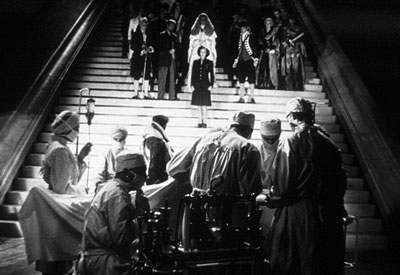 | |
Chosen by Jack Cardiff | |
|
"By the time that A Matter of Life and Death was made in 1945, Michael Powell was fast emerging as a director of exciting vision and innovative ideas. His partnership with Emeric Pressburger, a writer who possessed his own stimulating creative talent made a most seminal communion.
The film was made at the instigation of the Ministry of Information who wanted propaganda stressing the need for goodwill between Britain and America. But the fact that A Matter of Life and Death was filmed soon after the end of WW2 gave it a broader significance than just Anglo/ American propaganda. It became in one sense an appeal for tolerance in the face of the nuclear age. At the start of the film the audience is given a guided tour of the universe showing the alternative to peace. A plant explodes in a great ball of flame. The voice says: "someone’s been messing around with the uranium atom again". A Matter of Life and Death is a bizarre outrageous fantasy full of wit, marvellous sets, Technicolor, and beautifully played performances.
The story centres around RAF pilot Peter D. Carter (David Niven) who bales out of his blazing plane without a parachute and survives, at least in his tormented mind. He was obviously due to die and a heavenly messenger is sent to Earth to collect him. But Carter disagrees because he has fallen in love and a celestial tribunal ensues to judge his case while back on Earth, a doctor fights to save his life.
The scientific sequences are given a logical scientific explanation. The trial in heaven is the figment of a highly imaginative but disordered mind, its way of coping with critical brain surgery. Apparently, all the symptoms and diagnosis are medically correct, according to a medical researcher. What makes the film so remarkable is the assurance of Powell’s direction, which manages to make Heaven at least as convincing as Earth. The celestial scenes are black and white, the terrestrial ones are in colour, a sly assertion of a greater realism in that which is imagined? In wit, design and execution, the film is extremely sophisticated with many hilarious swipes at national stereotypes, and a love story that is as moving as it is dreamlike. Today, over half a century later, it is surprisingly up to date with all the inanities of modern life. It is reassuring indeed and most flattering that my photography received such appreciative comments. Working with Michael Powell was a wonderfully stimulating adventure. He somehow brought out all the creative approaches one possessed. He was never afraid of updating any ideas, however daring, if it fitted in to the story. This was before special effects was to become such a major part in films and I am glad that I escaped its brilliant tyranny. When we first see a big long shot of a deserted beach where Carter is washed ashore, Michael sighed how he wished that we had something different from the conventional fade in from black. I asked Michael to look through the camera and then exhaled my breath all over the lens. This fogged up the picture completely but through four seconds the breath fog cleared. Michael loved it and this might have been the only breath fade-in in film history!
To many, this film has turned out to be well ahead of its time, and I am proud to be associated with such a pinnacle of achievement. A Matter of Life and Death was chosen for the first Royal Command Performance film which Variety said it was equivalent to winning six oscars. The reviews were mixed. Some said "visually dazzling", but to most critics at the time, the film was somewhat bewildering, as it did not conform to a particular genre, "displaying a witty playfulness not considered at all British". It is however today regarded as one of the most important British films ever made.
Jack Cardiff, 1999
|
 |
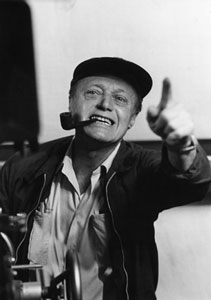 | |
Biography Jack Cardiff | |
|
Born at Yarmouth – England – 1914. The son of travelling players, Jack Cardiff started as a child actor, prior to switching to camera in 1928 and establishing himself as a leading director of photography when his name became synonymous with Technicolor especially through his collaboration with Michael Powell on A Matter of Life and Death, Black Narcissus (Oscar for Best Cinematography) and The Red Shoes, and with John Huston (The African Queen), Alfred Hitchcock (Under Capricorn), King Vidor (War and Peace), Mankiewicz (The Barefoot Contessa), Richard Fleischer (Conan the Destroyer), G.P Cosmatos (Rambo 2). From 1953, following his aborted debut as director in Italy with Errol Flynn, he has made over 15 films including Sons and Lovers, The Lion, My Geisha, The Long Ships, Young Cassidy (after John Ford had to retire) and Girl on a Motorcycle. His autobiography "Magic Hour" (Faber and Faber, London, 1996) is the personal journey of an extraordinary craftsman of the cinema.
Filmography as a director (his credits in the cinematography department include over 80 films). William Tell (1953), not completed; Intent to Kill (1958); Beyond This Place (1959); Scent of Mystery (1960); Sons and lovers (1960); My Geisha (1961); The Lion (1962); The Long Ships (1963); Young Cassidy (1964); The Liquidator (1965); The Mercenaries (1967); Girl on a Motorcycle (1968); Penny Gold (1973); Mutations (1974); Delius (1989), documentary; Vivaldi’s Four Seasons (1991), documentary.
|
 |
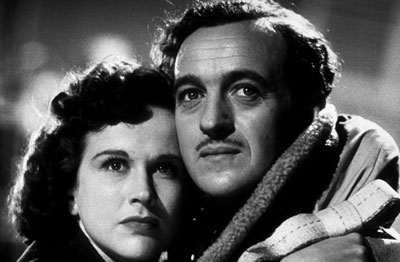 | |
Credits | |
|
A Matter of Life and Death
1946, colour, 35 mm, 1:1,33
Directors – Producers – Script: Michael Powell, Emeric Pressburger. Production: The Archers. Executive producer: The Rank Organisation. Associate producer: George R Busby. Assistant director: Parry Jones. Director of photography: Jack Cardiff. Camera: Geoffrey Unsworth. Decoration: Alfred Junge. Editor: Reginald Mills. Music: Allan Gray. Costumes: Hein Heckroth. Duration: 104 min.
David Niven (Peter Carter), Kim Hunter (June). Marius Goring (Conductor 71), Roger Livesey (Dr Reeves), Robert Coote (Bob), Kathleen Byron (Angel), Richard Attenborough (English Pilot), Raymond Massey (Abraham Farlan).
|
 |
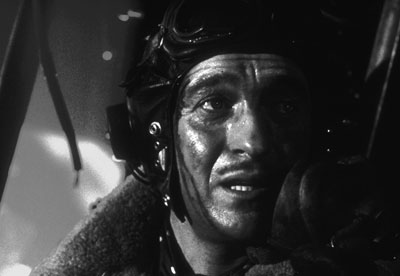 | |
Synopsis | |
|
Squadron leader Peter Carter (David Niven) is alone in a blazing plane over the English Channel and is about to bail out without a parachute. During what he feels are his last moments Peter confides to a young American WAC (Kim Hunter) his thoughts on love and poetry. Then he jumps, falling through the fog into the sea and is washed ashore. He appears to be unhurt and by some strange coincidence meets the WAC and falls in love. Carter has actually suffered severe concussion and he experiences strange hallucinations in which he sees characters from the Other World including an 18th century French Conductor (Marius Goring) who tries to get him to leave for the Other World.
Peter is treated by a brain surgeon Dr Reeves (Roger Livesey) for his headaches. After the doctor is killed in an accident Peter undergoes a serious brain operation. Meanwhile Dr Reeves reappears in a courtroom and is appointed Counsel for the Defence, in a strange trial for Peter’s life.
|
 |
About the film | |
|
A Matter of Life and Death is my favourite Archers film (Colonel Blimp is Emeric Pressburger’s favourite). It was the title we had given to the story commissioned by the Ministry of Information to improve Anglo-American relationships and which Emeric and I decided should be a love story. Emeric’s interpretation of the M o I’s original brief created plenty of scope for the director. Also for the designer, the cameraman and the special effects boys. His first draft of this story was full of fantasy, lighthearted miracles, mysterious appearances and disappearances. I decided that my job was to make each world as real as the other. I went back to my brother-in-law, a surgeon. He put me on medical textbooks which gave me the idea of staging hallucinations in space, not in time. At the same time I was ferreting through the anthologies to choose deathless lines from English verse, which Peter could spout in the burning plane on the way to eternity. Emeric had followed up his idea of shooting This World in Technicolor, and The Other World in black and white.
On the day that Japan surrendered to General MacArthur, we started shooting on location in North Devon. The beach was thick with unexploded bombs. It was just the right atmosphere for the picture to start in. The script called for a boy with some animals, who had to answer David Niven’s question when he thinks he’s in Heaven: "where do I report?" I made the boy a naked boy, playing on a reed pipe, while his goats cropped the sparse grass on the sand dunes. It looked charming. David kneels down and talks to the child, and gradually begins to realise that he is not dead. But our American partners could only see sexual implications in the association of a grown man with a naked boy. They cut the scene out in America, although there were important plot lines which played back to the earlier scene between June and Peter. I have a great respect for the popular audience: they know what we [directors] are driving at before we know it ourselves. I direct on this assumption, which sometimes causes distributors to worry over scenes and themes which their public take in their strides. In America, this disagreement between the director of a film and its distributor is intensified. I had no doubt that the Hollywood censor, disapproved of my naked boy. He disapproved of almost everything.
A Matter of Life and Death is called Stairway to Heaven in the USA. This change of title seemed to illustrate a fundamental difference between the English and the American mind and outlook. We had been pleased with our title, so Emeric and I looked a bit blank when the film was finished, and two young New York lawyers, who were determined to take over the film business, said: "you can’t have ‘Death’ in the title. We are going to market it as Stairway to Heaven!" We had all survived a war with the greatest and most fanatical power in the world, sixteen million lives had been sacrificed. The words "life and death" were no longer the great contradictions that they had been. Out of this enormous holocaust, Emeric and I were trying to create a comedy of titanic size and energy. Two worlds were fighting for one man’s life. It was indeed a matter of life and death. And now we were told that we couldn’t have "death" in the title. But we had become anxious about Arthur Rank’s promises about world distribution, and it was exhilarating to know that these two young enthusiasts were going to start their career with our film. After all, there was a stairway in our film, and it did lead to another world, although throughout the film we were careful not to use that mighty word, Heaven.
Edited extracts from Michael Powell’s autobiography "A Life in Movies", published by William Heinemann Ltd (1986, Great Britain).
I’ve come to realise that my favourite film is Powell and Pressburger’s A Matter of Life and Death, but it’s taken time to admit this... What I’d discovered were British film makers who lived up to the passion and sophistication I found in cinema elsewhere. Powell and Pressburger were a far cry from the cosy British cinema I had learned to despise, whether this was in the form of Dirk Bogarde "Doctor" comedies or the trendier "realism" of the 1960s. And for a Godard enthusiast, Marius Goring’s immortal line in A Matter of Life and Death – "One is starved for Technicolor up there" – was sheer delight. Wit, irony, modernism – and in British cinema of the 1940s!
The miracle of A Matter of Life and Death was that it managed to link an "official" theme – trying to improve post-war Anglo-American relations – with a variation on the 1940s enthusiasm for convoluted dream narratives (Hitchcock’s Spellbound appeared the year before) and some distinctly English motifs, hitherto rarely found in cinema. Squadron leader Peter Carter (David Niven), miraculously alive after jumping from his blazing bomber without a parachute, is both a tricky medical "case" for his doctors and a poet who translates his dilemma into a "case" to be heard before the heavenly court. Medicine and metaphysics combine to create a true modern allegory.
Ostensibly there are two love affairs at issue – the romance between Peter and an American ground controller (Kim Hunter), and Britain’s post-war relationship with America – but it is clear that the film is really about negotiating between the past and the future, and about cinema itself as, in Paul Virilio’s phrase, a "vision machine", something which allows us to see more clearly and comprehensively. Two literary clues to its theme are a quotation from Shakespeare’s "two worlds" fantasy A Midsummer Night’s Dream, seen in rehearsal at the airbase, and John Bunyan’s greeting to Peter on his way to plead his heavenly case. Powell and Pressburger had already made their khaki pilgrim’s progress two years earlier in A Canterbury Tale. But they were still fascinated by that English visionary tradition, which stretches from Bunyan and Blake to Kipling and Stanley Spencer, of revealing the supernatural within the everyday.
So it is possible to read the film’s most spectacular image, a giant escalator linking earth and heaven, as an ironic latter-day Jacob’s Ladder; while the breathtaking use of Technicolor to shift us between worlds, supervised by Jack Cardiff, deliberately draws attention to the artifice of film itself. Powell and Pressburger’s neo-romanticism in fact links them to the mainstream of reflexive modernism.
But did I really want to admit that a British film was my all-time favourite? Was this not somehow rather parochial? The more I looked into pro and anti-Powell/Pressburger attitudes, the more I realised that overcoming a massive prejudice against British cinema was essential, and that A Matter of Life and Death had first unlocked that door for me. And I am still learning from it.
Ian Christie. Extract of an article published in The Times, London. Ian Christie is the author of a book on A Matter of Life and Death to be published in 2000 in the BFI Film Classics Collection
|
 |
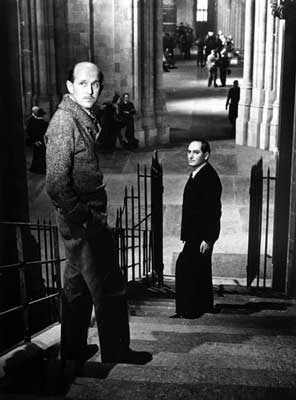 | |
Biography Michael Powell | |
|
Born in Canterbury, England, 1905 . Died at Avening, England, 1990. Michael Powell left school at 16 to become a bank clerk, but his interest was already in film. In 1925 he found work at Rex Ingram’s Victorine studios in Nice. Back in England he learned his craft on ‘quota quickies’, directing over twenty films between 1931 and 1936 when he made his first personal project, The Edge of the World (1937). Following the success of The Spy in Black (1939), the film through which he met his future partner, Emeric Pressburger, he was invited by Alexander Korda to co-direct The Thief of Bagdad (1940), his first realisation of the creative potential of colour. In 1942 Powell and Pressburger formed the Archers, a partnership which was to give British cinema one of its most original body of work with films such as The Life and Death of Colonel Blimp, A Canterbury Tale, I Know Where I’m Going, A Matter of Life and Death, Black Narcissus and The Red Shoes (Oscar for Best Director). By the late 1940s, the partnership was running out of steam, increasingly embattled with the great moguls in their fight to prove that art could be box-office. Michael Powell went on setting up his own projects the most notable of which was Peeping Tom (1960), which shocked the world and prematurely ended his career. In the later years, in the entourage of Coppola and Scorsese, with the support of his third wife, the editor Thelma Schoonmaker, and a growing number of filmmaker enthusiasts, he continued to be an ardent exponent of his vision of a pure cinema, not least in his two volume autobiography "A Life in Movies".
Filmography as director:
The Crowded Hours (1931), short; My Friend the King (1931), short; Rynox (1931), short; The Rasp (1931), short; The Star Reporter (1931), short; Hotel Splendide (1932), short; C.O.D (1932); His Lordship (1932); Born Lucky (1932); The Fire Raisers (1933); The Night of the Party (1934); Red Ensign (1934); Something Always Happens (1934); The Girl in the Crowd (1934), short; Lazybones (1935); The Love Test (1935); The Phantom Light (1935); The Price of a Song (1935); Someday (1935); Her Last Affaire (1936); The Brown Wallet (1936); Crown v. Stevens (1936); The Man Behind the Mask (1936); The Edge of the World (1937); The Spy in Black (1939); The Lion Has Wings (1939); Contraband (1940); The Thief of Bagdad (1940), co-director; An Airman’s Letter to His Mother (1941), short; 49th Parallel (1941); The Silver Fleet (1943), as producer; Luna de Miel (1959); Peeping Tom (1960); The Queen’s Guards (1961); Never Turn Your Back on a Friend (1963), short; A Free Agent (1964), short; Bluebeard’s Castle (1964); The Sword Twelve (1965), TV; A 39846 (1965), TV; They’re a Weird Mob (1966); Age of Consent (1969); The Boy Who Turned Yellow (1972), short.
As co-director, co-producer, co-writer with Emeric Pressburger:
One of Our Aircrafts is Missing (1942); The Life and Death of Colonel Blimp (1943); The Volunteer (1943), short; A Canterbury Tale (1944); I Know Where I’m Going (1945); A Matter of Life and Death (1946); Black Narcissus (1947); The End of the River (1947), as producer; The Red Shoes (1948); The Small Back Room (1949); Gone To Earth (1950); The Elusive Pimpernel (1950); The Tales of Hoffmann (1951); The Sorcerer’s Apprentice (1955), short; Oh... Rosalinda! (1955); The Battle of the River Plate (1956); Ill Met By Moonlight (1956).
|
 |
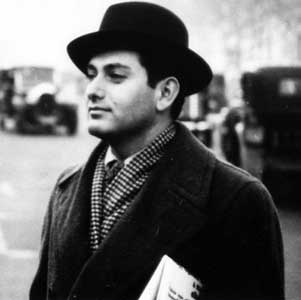 | |
Biography Emeric Pressburger | |
|
Born in Miskolc, Hungary, 1902. Died at Aspall, England, 1988. Emeric Pressburger studied engineering in Prague and Stuttgart. In Berlin he trained in Ufa’s precise scriptwriting style and detailed pre-production over a dozen commercial comedies and operettas by the likes of Robert Siodmak, Max Ophüls, Billy Wilder and Reinhold Schünzel. After fleeing the Nazis in 1933, he worked briefly in France. In 1935 he was hired by fellow Hungarian Alexander Korda’s London Films. He went on writing several anti-nazi scripts for the Ministry of Information and met Michael Powell with whom he formed the legendary production partnership the Archers. "Written, directed and produced by Michael Powell and Emeric Pressburger" famously topped the credits of 17 films between 1942 and 1956 which included their best work. Pressburger received an oscar for best original screenplay on 49th Parallel (1941). His projects after the Archers, were mainly frustrating experiences somewhat compensated by the success of the first of his two novels: "Killing a Mouse on Sunday"( 1961), which was filmed by Fred Zinneman as Behold the Pale Horse (1964), and "The Glass Pearls" (1966).
Filmography (see also Michael Powell):
The following credits are as co-scriptwriter unless stated otherwise: Abschied (1930); Das Ekel (1931); Dann Schon Lieber Lebertran, short; Der Kleine Seitensprung; Emil und die Detective; Ronny; Das Schöne Abendteuer (1932); Wer Zahlt Heute Noch? short, script; Lumpenkavaliere, as co-editor; Sehnsucht 202; Eine von Uns (Gilgi); ...Und es Leuchtet die Puszta (Bie uns in Budapest...) (1933), script; Son Altesse Voyage, script; Une Femme au Volant, script; Mon Coeur t’appelle (1934); aka "The Satyr" (1935); One Rainy Afternoon (1936); La Vie Parisienne, script; The Challenge (1938), script; The Spy in Black, script; Spy for a Day (1939); Contraband (1941), co-script with Powell; Atlantic Ferry, story; 49th Parallel, script; Breach of Promise (1942) , story; Squadron Leader X (1943), story; Wanted for Murder (1946); Twice Upon a Time (1953), dir/prod/script; Miracle in Soho (1957), prod/script; Operation Crossbow (1964), script; They’re a Weird Mob (1966), script; The Boy Who Turned Yellow (1972), short, script.
|
 |
|
__________
In the UK, the 15x15 programme was developed by Bradford International Film Festival Pictureville, Bradford BD1 1NQ – +44.1274.203.345 – francois@ballay.demon.co.uk
Pictures and prints of A Matter of Life and Death courtesy of Carlton International Media ltd. Pictures of Michael Powell and Emeric Pressburger courtesy of the British Film Institute. Picture of Jack Cardiff courtesy of Modus Operandi Films.
|
 |
|
|
 | 
|